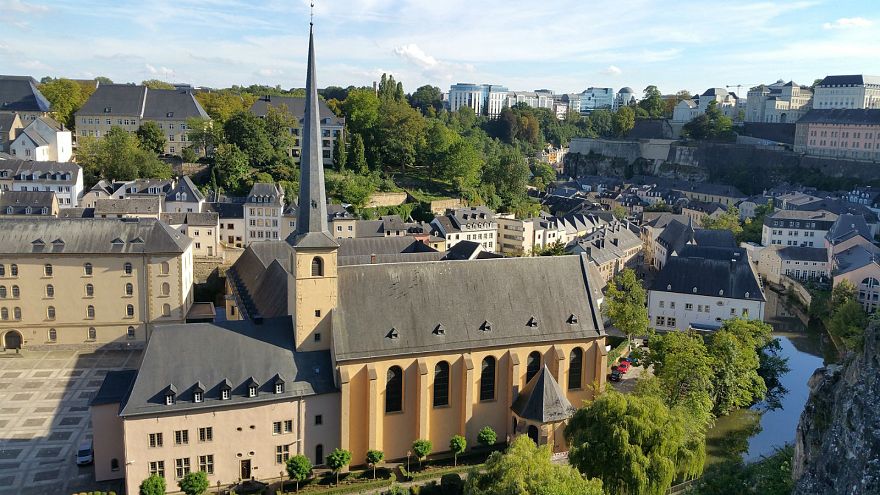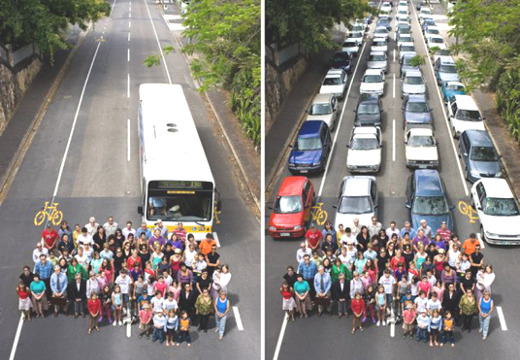'I leave the car at home': how free buses are
revolutionising one French city
One month after the
French channel port of Dunkirk introduced free public transport for all, a
small revolution is taking place.
The free bus service in Dunkirk was initially offered on weekends and
national holidays but was extended a month ago to operate every day. Photo:
Francois Lo Presti/AFP/Getty Images
Dunkirk is a month into a
project that makes it the biggest European city to offer entirely free public
transport to residents and visitors alike. So what do people think?
Two women, perfect strangers until now, are chatting across
the aisle about nothing in particular. One admits she sometimes takes the bus
“just for the fun of it”. A young man wearing headphones is charging his mobile
in a socket just above the “request stop” button.
On another bus, Claude
Pointart, 65, who is retired, says free buses mean her pension goes
further. “I’m saving money and they come every 10 minutes so I don’t have to
wait long. But there’s a lot more people taking the bus so you have to avoid
the rush hour if you want to sit. Still, I think it’s a good thing.”
Claude Pointart, a passenger on a Dunkirk bus. Photo: Emmanuelle Depecker
On a city bus making its way around the historic port city,
passengers smile at the driver and say “Bonjour” as they board. Some of the
city’s fleet of new buses, painted in dazzling colours – pink, orange, green,
yellow and blue, with upholstery to match – have wifi. The urban authorities
have plans for debates, music and possibly the occasional celebrity on board. A
“Sport-Bus” with an interactive game, quiz screen and a selfie camera is
already in operation.
Georges Contamin,
51, says he has reconsidered how he travels about the city since the buses
became fare-free. “Before, I almost never took the bus, but the fact they are
now free as well as the increase in the cost of car fuel has made me reflect on
how I get about,” Contamin says: I never used the bus before. It was too much
bother getting tickets or a pass.
Marie, passenger: 'It's so easy'
At the bus stop opposite the port, even the persistent
drizzle and howling wind rocking the boats cannot dampen Marie’s enthusiasm. “I never used the bus before,” she says. “It
was too much bother getting tickets or a pass. Now I leave the car at home and
take the bus to and from work. It’s so easy.”
One month ago, Dunkirk – with a metropolitan population of
200,000 – became the largest city in
Europe to offer
free public transport. There are no trams, trolleybuses or local commuter
trains, but the hop-on-hop-off buses are accessible and free – requiring no
tickets, passes or cards – for all passengers, even visitors .
The scheme took its inspiration from Tallinn in Estonia,
which in 2013
became
the first European capital to offer a fare-free service on buses,
trams and trolleybuses, but only to residents who are registered with the
municipality. They pay €2 for a
“green card”,
after which all journeys are free. The city has reported an increase of 25,000
in the number of registered residents – the number previously stood at 416,000
– for which the local authorities receives €1,000 of each resident’s income tax
every year.
Residents of Tallin in Estonia pay €2 for a green card which gives them
free access to buses, trams and trolleybuses. Photo: STRINGER/EPA
Free urban transport is spreading. In his research
Wojciech Keblowski, an expert on
urban
research at Brussels Free University, says that in 2017 there were
99 fare-free public transport networks around the world: 57 in Europe, 27 in
North America, 11 in South America, 3 in China and one in Australia. Many are
smaller than Dunkirk and offer free transit limited to certain times, routes
and people.
In February this year,
Germany
announced it was planning to trial free public transport in five
cities – including the former capital Bonn and industrial cities Essen and
Mannheim.
In
June this was downgraded to a slashing of public transport fares to
persuade people to ditch cars.
The largest in the world is in
Changning , in
China’s Hunan province,
where free transit has been in operation since 2008. Passenger numbers
reportedly jumped by 60% on the day it was introduced.
A study into free public transport by online journal
Metropolitics
found an increase in mobility among older and younger people, and an increased
sense of freedom.
France
Niort in west
France introduced
free buses for its 125,000 residents a year ago. Like Dunkirk, its income from
fares was around 10%. The city authorities say passenger numbers have been
boosted by 130% on some routes.
One month on, the Dunkirk
mayor, Patrice Vergriete, who promised free public transport in his 2014
election campaign, says the project has been an overwhelming success, with a
50% increase in passenger numbers on some routes, and up to 85% on others.
Sitting in his large office under a poster of Nelson
Mandela, Vergriete claims it is a win-win measure for his home city, where
previously 65% of trips were made by car, 5% by bus and 1% by bicycle. The
other 29% walked.
“The subject of free public transport is full of dogma and
prejudice and not much research. This dogma suggests that if something is free
it has no value. We hear this all the time in France,” he says.
Free public transport for Dunkirk was a key promise of Mayor Patrice Vergriete’s
2014 electoral campaign. Photo: youaintseenme/Getty Images/iStockphoto
Money, he says, is the obvious inconvenience. Before the
buses were free, fares raised around 10% of the network’s €47m (£41.6m) annual
running costs. A further 60% was funded by the versement transport, a
French public transport levy on companies and public bodies with more than 11
employees, and 30% came from the local authority. Vergriete says a rise in the
company transport tax has made up the fare shortfall – meaning no rise in taxes
for local households.
Bus routes have been extended, with special lanes and city
centre priority introduced. The fleet has been expanded from 100 to 140 buses,
including new greener vehicles which run on natural gas.
“The increase in passengers since it went free has surprised
us; now we have to keep them. We’re trying to make people look at buses
differently. We have put the bus back into people’s head as a means of
transport, and it has changed attitudes.
It may be that the financial cost is too great, but don’t
underestimate the social advantages. You can’t put a price on mobility and
social justice.
Dunkirk Mayor: ‘You
can’t put a price on mobility and social justice’
“Before, when they paid, it was a service and they were
customers. They may have been only contributing 10% of the cost of running the
service but they thought it was theirs. Now it’s a public service they look at
it differently. They say ‘bonjour’ to the driver, they talk to each other. We
are changing perceptions and transforming the city with more vivre ensemble.
We are reinventing the public space.
“Before the bus was for those who had no choice: the young,
the old, the poor who don’t have cars. Now it’s for everyone.”
Free public transport, however, also has its critics. The
French transport union UTP believes fare-free transport is often “associated in
France with a lack of value and, by extension, a lack of respect”.
Claude
Faucher of the UTP said:
“That it should be free for those passengers with financial difficulties …
could be perhaps justified. However, completely fare-free for all users would,
we believe, deprive [public] transport of resources that are useful and
necessary for development.”
In Paris the income from tickets on public transport is
reported to make up half the running costs. When mayor Anne Hidalgo suggested
she would look at scrapping fares, Frédéric Héran, a transport economist, said
the measure “made no sense”.
“Who will the new public transport users be?” he asked. “All
studies have shown they will be cyclists, then pedestrians and very few
motorists. This clearly shows it’s an anti-cycling, anti-pedestrian measure and
not very discouraging to cars.”
Vergriete
believes this is all part of an erroneous received dogma. He admits free public
transport may not work everywhere, but says that, as well as being good for the
environment, it is a social measure, a gesture of “solidarity” and promotes a
more egalitarian redistribution of wealth than tax cuts.
“We have been
pragmatic: we looked at the advantages of free transport and weighed them
against the disadvantages and decided €7m is not a lot to pay for all the
benefits.
If I can pass one message to other mayors it’s to fight the
dogma. Put the advantages and disadvantages on the table and consider it
realistically. It may be that the financial cost is too great, but don’t
underestimate the social advantages. You
can’t put a price on mobility and social justice.”
Passengers wait on a Paris metro platform. Photo: Alamy Stock Photo
This Guardian article has been reprinted
by FareFree New Zealand, October 2018. [Slightly abridged]
Email the editor:
roger.fowler@icloud.com
 Bettel, (pictured) who took office for a second term on Wednesday, made environmental protection a key part of his election campaign.
Bettel, (pictured) who took office for a second term on Wednesday, made environmental protection a key part of his election campaign.











